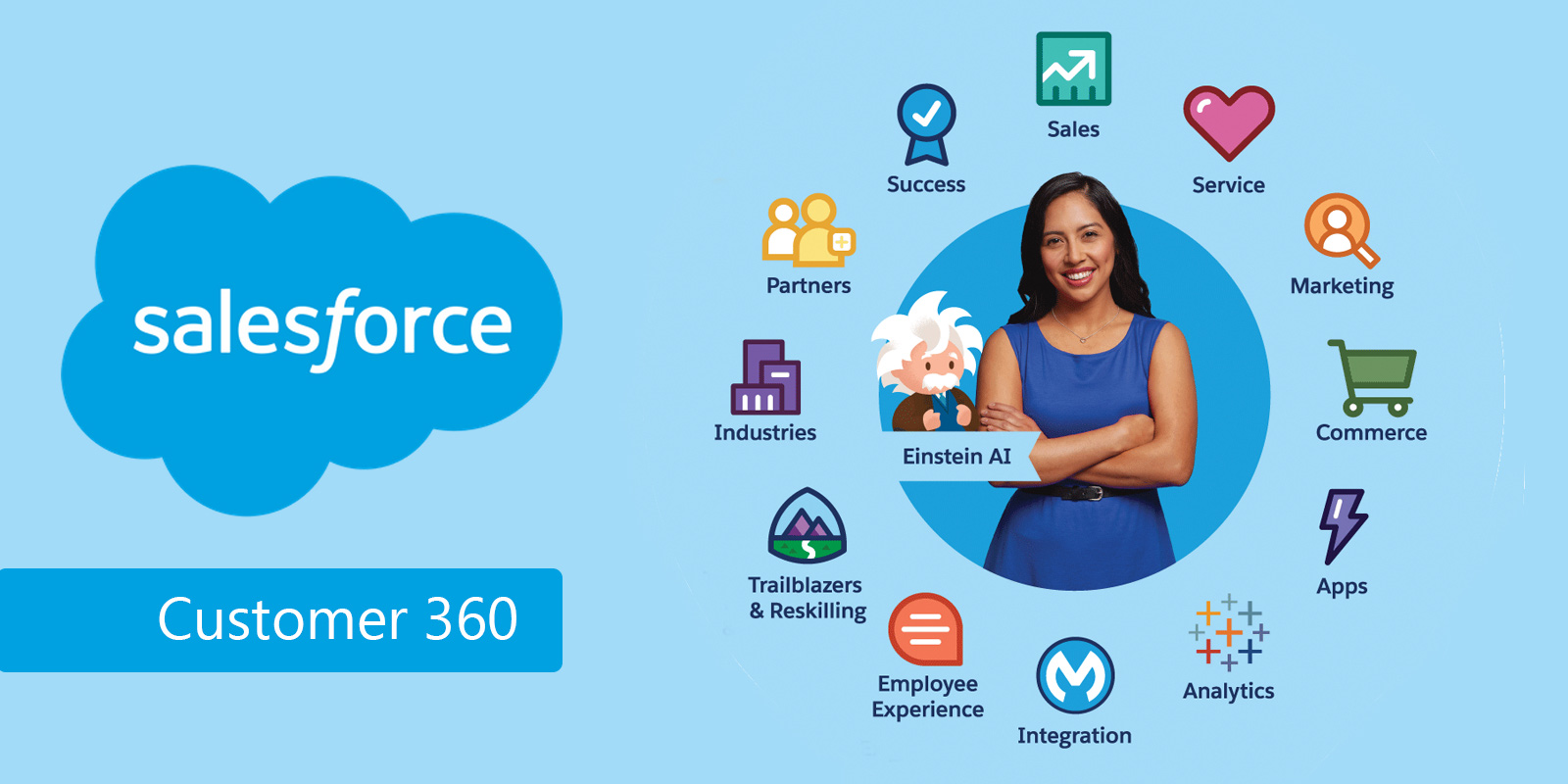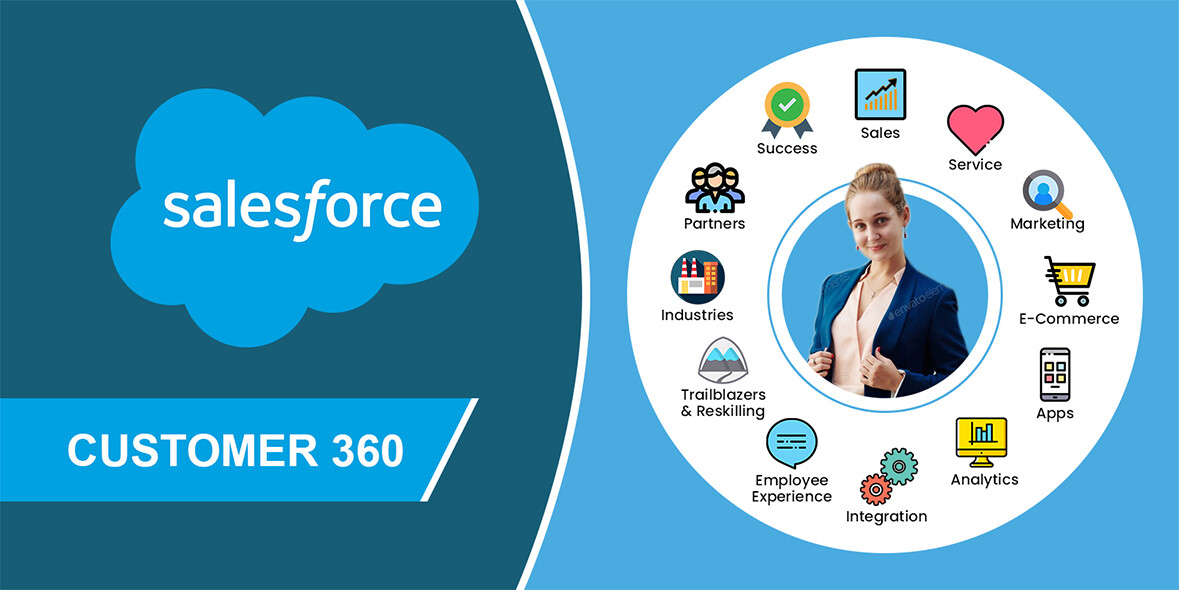Salesforce is a Service as a Software (SaaS) lead generation company, with powerful Customer Relationship Management (CRM) services that allow businesses to use cloud technology to connect with partners and customers.
The company recently impressed investors by reporting a third-quarter revenue of $4.5 billion – up 33% year over year.
The company was founded by former Oracle executives Marc Benioff, Frank Dominguez Dave Moellenhoff, and Parker Harris in 1999
Salesforce leverages cloud technology and has built a variety of applications for businesses to connect to their customers.

(Image Source: Rolustech)
Lead Generation with Salesforce
1. By Asking For Referrals
Referrals are the best lead generation strategy out there and happy customers are happy to give referrals.
You can let your customers broadcast your business for you by asking for referrals and empowering them to gather their own leads.
When customers are happy, they tell their friends and family about you. When they do that, they indirectly boost your company’s credibility greatly.
Therefore, when closing a sale, make sure to ask your buyer if they know anyone who might need your service or product.
This process is a quick way to generate leads. It should be brief and not time-consuming.
2. By Conducting Regular Customer Care Calls
It is essential to follow up on your customers after a sale. When a customer is happy and has a continuous relationship with your company, they are likely to buy from you again.
Frankly, it is a lot cheaper to sell to an existing customer than to struggle to acquire a new lead. The strategy of using Follow-up calls is a fantastic and reliable way to nurture customer relations.
It could even serve as a great time to ask for referrals. Because sometimes, the best quality leads you have are your current customers.
You need to have proactive customer care in order to engage your customers frequently. And this, in the long run, will build your brand loyalty and high levels of customer satisfaction.

(Image Source: A Better Answer)
3. By Nurturing Your Leads
Not every lead you get will be ready to convert immediately. But you still have to pay attention and take note of their actions.
Nurturing your leads is essential in the lead generation process–especially when prospects are undecided.
You could send them helpful information based on their interests. You can also go further to automate the lead nurturing process and even set up reminders and a schedule of when to check in with them.
By doing this, you will be the first in mind whenever they are ready to make a buying decision.
4. Be a Reliable Information Source
Customers prefer to buy from or patronize someone whom they can trust, especially when that person or company is a reliable expert in a particular field of interest.
You should strive to boost your customers’ confidence in you by becoming an advisor in your field rather than just being an ordinary salesperson.
Bear in mind that customers like to do most of their research before talking to a sales representative or even before walking into a shop/mall.
You can achieve this process of becoming a trusted source of information by speaking at trade shows or conferences.
The knowledge the customers get from the information you give will help them make the best decision. And they will most certainly prefer to buy from you or request your services.
5. Showcase Your Knowledge, Services and Products
It has become a lot easier to do this by adopting the use of the internet. You can showcase your services and product by setting up a web presence.
This will help you reach any potential clients that might need knowledge regarding products or industries.
You could start acquiring views by using targeted content optimization for search engines to increase your website’s rankings.
By continually adding helpful and relevant content to your website, you could quickly generate leads through the internet.
These contents will assist your potential customers in their research process. But be sure to use form entries with Call To Action (CTAs) throughout your site to capture these leads.
6. Use Online Networking

(Image Source: Adobe Blogs)
Online networking sites like LinkedIn and Facebook have become the main platforms professionals use to stay in touch with people. This has, in time, become a perfect means of reaching new leads from around the world.
It is important to join these platforms and use the available tools to connect with and stay in touch with your potential clients/customers.
And once you’ve connected with potential customers on these networking sites, make sure to nurture those connections. Read what your prospective clients are reading and then tweet or post about it.
Make sure to post valuable content regularly. It increases your ability to be a trusted source for customers while they research their purchase.
Publish articles, sponsor updates on the site, and add pieces of advice for followers. Also, put you and your company in the spotlight as a trusted expert in your field.
You should include a call-to-action button on social media too to drive leads.
8. Engage in Physical Networking
Some people prefer meeting face to face with a salesperson because it allows them to read body language and facial expressions which builds trust and confidence.
It also gives customers a chance to voice out their questions and what they are thinking.
Be present at conferences–organize seminars and workshops with the aim of being present where your prospective clients are.
You could even join organizations that your potential clients are likely to join. Make sure to attend the conferences they are a part of as well. This will put you in the right place with the opportunity to interact with a large pool of prospects.
And while you are with your prospects, make sure to listen carefully as they speak their minds. This will give you the opportunity to offer solutions and meet their needs.
9. Use Your Creative Ability

(Image Source: XpandRetail)
Your creative ability gives you an edge over your competitors. You have to always think of other new ways to interact with potential customers and generate new leads.
Find out some tactics your competitors are not thinking of and try it. Also, find out other tactics your competitors are using that works, and improve on them.
The idea is to be better than your competitor at all costs.
These strategies might include sponsoring charity events or educational luncheon. Hosting or sponsoring these events will serve as a perfect platform for interacting with your community and generating leads.
10. Be Strong-Willed
Perseverance is an essential virtue and quality you must possess to succeed in the lead generation business.
Lead generation is never an easy task. You will encounter a lot of challenges, regardless of the strategy you choose to apply. But in the face of these challenges, you must be determined to succeed.
More Salesforce Lead-Generation Strategies for B2B Businesses

(Image Source: eBiz Solutions)
1. Maximize the Use of Your Social Channels
Studies show that about 20% of business users have switched from email to social media as their primary form of communication.
You can harness the power of your social media presence for generating leads by adopting the very social media platforms your leads use. You should also learn and understand how they use them. Afterward, design your lead-generation strategy to match their preferences.
Also, since social channels have become the complete tool for people to look for answers, you should develop a system for recognizing where a potentially buying lead is based on the kinds of questions they ask online.
Make sure to interact with them in a casual but professional way on social platforms.
20% of business users have switched from email to social media as their primary form of communication Share on X2. Offer Consistent Quality Content
The quality of the content you publish and how you promote it to reach the right audience is important.
If you want to record constant success, make sure you approach your content strategy from the customer’s perspective.
You must know what B2B buyers are looking for. So that when they look at the content on your website, they won’t look anywhere else. The content you publish must be valuable to your readers, such that they can benefit from it and even take action after reading.
Make sure that every piece of content is of value to the reader. By publishing reliable and high-quality content, you will attract good leads who are ready to form a relationship with your business.
3. Adopt the use of quality Data Analysis and Reports
According to a study on BrightTALK, 42% of marketers indicated that the primary barrier to lead generation was problems with data quality.
Therefore to avoid this problem among your buyers, it is essential to analyze various lead behaviors over long periods to acquire crucial details about the buyer.
Proper quantitative data analysis will show you how your leads interact with your website at different specific times.
It will reveal what drives them to a particular piece of content and how they react to certain elements.
It will also help you create an intuitive lead scoring system that can help you identify higher quality contacts.
Reports show that companies who have a lead scoring process experience a 77% increase in lead-generation ROI compared to those who don’t have one.
While you adopt quantitative data analysis for your lead-generation techniques, make sure you consider qualitative analysis too.
companies who have a lead scoring process experience a 77% increase in lead-generation ROI compared to those who don't have one Share on X4. Use the A/B testing for results
This process ensures that potential leads go through the process and conversion that will grow into a long-term partnership.
A/B testing is made to improve lead generation on your website. It allows you to implement and track the effects of these changes in detail.
You can subject your entire website experience to A/B testing. This can include your CTAs, pricing information, layout, design choices, etc.
5. Your Content Should Be Well Optimized Across Platforms

(Image Source: Pixcon Digital)
We now live in a mobile era. This means that your lead may start searching for solutions to their problems from a mobile phone during a morning commute.
They might continue the search afterward from a desktop once they get into the office. They could as well continue the journey on a tablet later in the day. You get the point.
Your leads may think of a crucial question they want to ask while browsing on a mobile device.
So make sure that your content is well suited to comply with and display properly across all digital devices in order to give your audience a smooth cross-platform digital experience.
Because if any part of the digital experience is lacking across the platforms your audiences use to interact with your brand, it could jeopardize the buyer’s journey. Hence leading the buyer to a different path.
One of the most important aspects of B2B marketing is to make sure the discovery process is as seamless as possible for the potential customer.
Lead generation process is accomplished even before the buyer has any strong feelings about your brand. Therefore, even the slightest inconvenience can have a significant negative impact on the outcome.
So, the experience should be standardized no matter what kind of device they are using.
Salesforce Lead Management
Leads can be manually entered into Salesforce or through a list import. They can also be entered via web-to-lead generation or through an automated Salesforce integration with your other business software.
When a lead is converted to a contact in Salesforce, the system automatically guides you through the process of creating new accounts, contacts, and opportunities.
The system also connects that data with the information that is already in its system
Salesforce has a reputation for maintaining the integrity of your existing data to avoid overwriting any critical information.
You can easily manage the leads by customizing the default settings for leads or by setting up lead assignment rules that keep data flowing through the pipeline and with information captured on forms on your website.
How to Convert a Salesforce Lead into a Contact
STEP 1. Find the lead you wish to convert. To do this, go to the detail page for that lead and click “Convert”.
STEP 2. Create a new account or find an existing one in the Account Name field. Note that the lead conversion will preserve existing account data by default.
But if you wish otherwise, you can choose to overwrite existing information.
STEP 3. In the Opportunity Name field, Name the opportunity as you desire. And if you like you can decline to create an opportunity. All that is required is to check the box accordingly.
STEP 4. Then, select the Task Information area and schedule any follow-up tasks that may be part of your business’s work-flow.
STEP 5. Click the Convert link.
The automation capability of the Salesforce system makes it possible for you to set up your Salesforce account to trigger a work-flow action any time you convert a new lead.
For instance, you can set it up to generate a custom email to your sales team urging them to get in contact any time a lead is converted. These automatically generated actions are logged in the Salesforce system and can be viewed by building reports.
Salesforce Opportunity functionality helps you track all the information relating to specific sales, campaigns, and pending deals.
Opportunity fields also make it easy to create lists of various types, such as products, quotes, and contacts. Opportunity fields can be customized, making it possible to create fields such as account and contact.
Salesforce also allows you to create custom fields that can be used to track specific data unique to your industry, business, and customers.
Mind you, when a newly entered lead matches an existing contact and share the same campaign, the furthest record in the life cycle of the campaign is the one that will be updated.
To avoid confusion, you can maintain an automatic synchronization process by using a tool like Formstack Sync to ensure consistent data without any coding or manual uploads.
Conclusion
Salesforce is a cloud-based software that allows companies to track analytics and it allows you to track customer success and support.
Salesforce helps you to attend to customer complaints and it also helps you carry out a variety of other CRM functions with the ease of cloud storage and access wherever you are.
Want to help contribute to future articles? Have data-backed and tactical advice to share? I’d love to hear from you!
We have over 60,000 monthly readers that would love to see it! Contact us and let's discuss your ideas!
